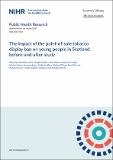The impact of the point of sale tobacco display ban on young people in Scotland : before and after study
Abstract
Background Tobacco displays at point of sale have been shown to increase young people’s pro-smoking attitudes, susceptibility to smoking and smoking initiation. In Scotland, legislation that prohibited tobacco point-of-sale displays was implemented in large stores (i.e. those > 280 m2) in April 2013 and in small retailers in April 2015. Objective To assess the impact of the point-of-sale tobacco display ban on young people’s exposure to tobacco advertising, their attitudes to smoking and smoking susceptibility, and their risk of smoking initiation. Design Multimodal before-and-after study design using mixed methods to collect data at baseline (2013) and then longitudinally for 4 years. Setting Four main study communities in the central belt of mainland Scotland, UK, purposively selected to reflect two levels of urbanity (urban vs. small town) and two levels of deprivation (high vs. medium/low). Four matched communities. Participants In the main study communities, 94 tobacco retail outlets. All Secondary 2 (aged 13 years) and Secondary 4 (aged 15 years) pupils in 2013 and 2014 together with all Secondary 1 to Secondary 6 (aged 12–17 years) pupils in 2015–17. This included 6612 pupils who completed 14,344 questionnaires over 5 years. Three hundred and eighty-two participants in 80 focus groups who were recruited from Secondary 2 and Secondary 4 in 2013–17. In matched communities, 24 retail panel members in 2013–17. Main outcome measures Tobacco product and tobacco storage visibility, density of retail outlets (the number of retailers in a pre-defined area such as a residential neighbourhood), tobacco product exposure, brand awareness, perceived accessibility of tobacco, pro-smoking attitudes, pro-smoking norms, smoking susceptibility and smoking initiation. Data platform and methods The study had four components – a mapping and spatial analysis of retail outlets; a tobacco marketing audit, including retail panel interviews in matched communities; school surveys; and focus group discussions with secondary school pupils. Limitations The study was based on a small number of communities and did not include communities in remote areas. Results Compliance with the point-of-sale legislation in Scotland was high. This led to a large reduction in the visibility of tobacco products in retail outlets. However, when the results were stratified by socioeconomic status, declines in retailer density, weighted by total product visibility, were restricted to the least disadvantaged tertile of participants. Nevertheless, the implementation of the legislation was associated with a reduction in risk of both smoking susceptibility and smoking initiation in young people, as well as a reduction in the perceived accessibility of tobacco and in pro-smoking attitudes after both the partial and the comprehensive bans were introduced. Conclusions The Scottish point-of-sale legislation has been successful in reducing the overall visibility of tobacco products and is associated with improvements in attitudinal and behavioural outcomes in young people. However, cues that tobacco is for sale are still highly visible, particularly in retail outlets in areas of deprivation. In addition, the increase in retailer density that was observed after 2015 increased inequalities in product visibility. There was also evidence that the emergence of e-cigarettes may have disrupted the full impact of the legislation. Future work Our research indicates that further research is needed to examine the longitudinal relationships between tobacco outlet availability and product visibility inequalities; and the impact of e-cigarettes and standardised packaging on smoking initiation and prevalence.
Citation
Haw , S , Currie , D B , Eadie , D , Pearce , J , MacGregor , A , Stead , M , Amos , A , Best , C , Wilson , M , Cherrie , M , Purves , R , Ozakinci , G & MacKintosh , A M 2020 , ' The impact of the point of sale tobacco display ban on young people in Scotland : before and after study ' , Public Health Research , vol. 8 , no. 1 . https://doi.org/10.3310/phr08010
Publication
Public Health Research
Status
Peer reviewed
ISSN
2050-4381Type
Journal article
Description
Funding: This project was funded by the National Institute for Health Research (NIHR) Public Health Research programme.Collections
Items in the St Andrews Research Repository are protected by copyright, with all rights reserved, unless otherwise indicated.

